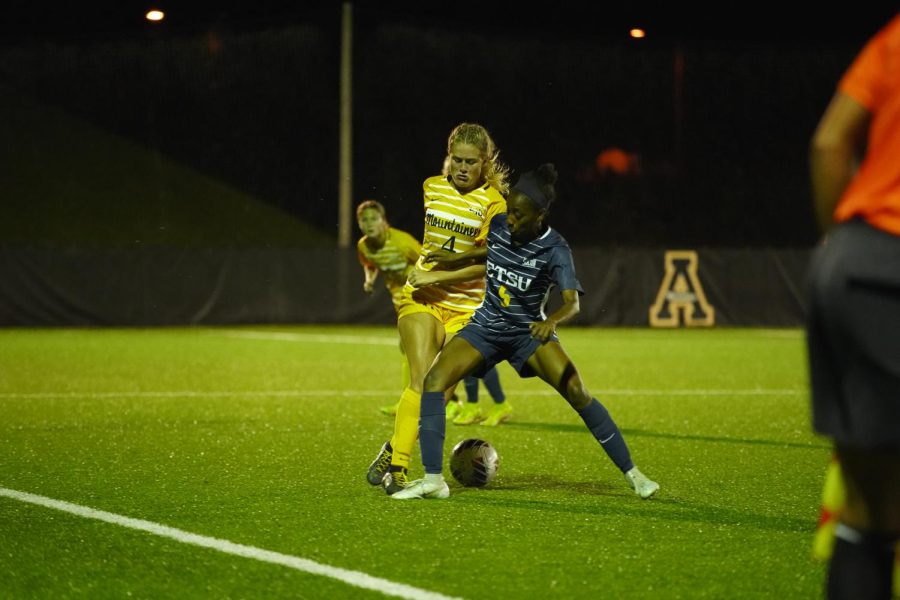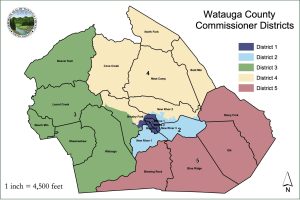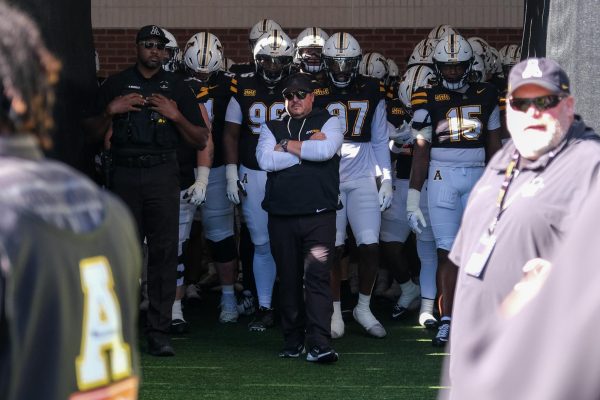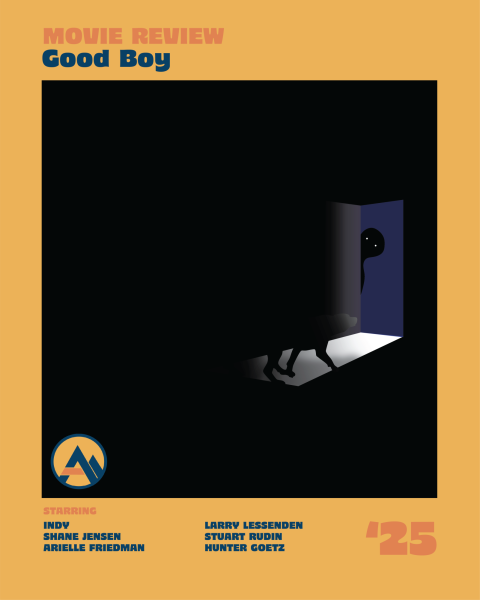Observations from App State soccer’s spring season
Junior forward Izzi Wood battles with a Buccaneer defender Sept. 8, 2023.
May 2, 2023
The spring season ended for Mountaineer soccer with a 3-1 win over Lees McRae April 17. With the win, App State women’s soccer season is in the rearview. Now, it’s time to reflect on the Mountaineers’ performance in the 2022-23 season.
The 2022-23 season marked a rebuilding period for App State soccer. This rebuilding began when the program transitioned leadership with a new coaching staff hired in December 2021.
Head coach Aimee Haywood replaced Sarah Strickland. Strickland transitioned to a new role in the athletics department after serving 12 years as head coach. App State Athletics announced the hiring of two assistant coaches, Mikayla Krzeczowski and Mark Catterall, in February 2022.
The team worked under new leadership to find their identity over the course of the year, both on and off the pitch. In the upcoming seasons, what this identity is will become clear.
In the fall season, the Mountaineers recorded six wins, five of which occurred during conference match play, nine losses and four draws. In the spring season, consisting of five friendly matches, App State soccer recorded three wins and two losses.
Wins and loss records are important, however, the tangible differences seen in Haywood’s side between fall and spring, tell far more about the character of the team and ability to grow in the coming seasons.
In the fall season, the Mountaineers played largely defensive soccer. They spent a significant amount of time in their matches out of possession attempting to regain possession and counter attack. As a result, they spent a lot of time off the ball reacting to what was happening on the pitch, rather than controlling it.
In the two home spring matches, against Davidson and Lees McRae, it was clear the Mountaineers had improved at controlling possession. App State soccer attacked relentlessly, having multiple opportunities to score everytime they were down the field. On the whole, the Mountaineers have moved from playing largely defensive soccer in the fall, to largely attacking soccer in the spring.
This is most likely due to a couple of things. What was apparent in the fall season was the team’s youth. Of a 24 player roster, nearly half of the team were underclassmen being coached by a completely new coaching staff.
Much of the time in the opening season was spent with the coaches learning the players, the players learning the coaches and the players building chemistry on the field.
This always becomes a challenge when adding new players to a squad, of which the Mountaineers added 11 new players in the signing window for the upcoming season.
On the one hand, the youth of a team can cause confusion. Players don’t yet know their roles or how to read one another and can lead to missed opportunities and goals.
On the other hand, the team’s youth becomes advantageous. If what one needs to develop cohesion is time, then having a large proportion of one’s team be underclassmen allows for this to happen. More often than not, the result of this time is uniformity, which maximizes scoring opportunities.
As the Mountaineers moved from defensive soccer to attacking soccer, they improved their ability to gain and retain possession of the ball. However, soccer is not just about having possession, it’s about what one does with the ball when one gets it.
This is where there is room for improvement. There is a lack of ability for players to consistently read one another on the pitch. This results in easy, avoidable losses of possession and failed attempts to carry the ball down the field and score.
App State soccer has promise. Much of the successful implementation of these tactics comes with time, which requires patience; something sports fans are not particularly known for having.
However, the Black and Gold have a talented group of players who are beginning to take ownership of their team, tactics and style of play. This is best seen in the attacking soccer style they adopted during the spring season.
Since the Mountaineers were defensively strong in their fall season, and did not yet have confidence on the ball and controlling the pitch, their most successful play in the fall came from kicking the ball up the pitch and attempting to steal a goal in the opponents defensive third, otherwise known in the United Kingdom as Route One soccer.
In the spring season, players were evidently more comfortable reading each other. They are beginning to learn from each other and understand how to work with their teammates to execute effective pressing movements and convert them into goals.
Haywood said she gave her team significant control over how they wanted to approach these spring matches, and they responded with a desire to press. This is a marker of how their confidence as a team has grown between seasons. The relatively successful implementation of these attacking tactics will only bolster their confidence in upcoming seasons.
All of this helped the Black and Gold build confidence in their ability and made them more comfortable with the idea of pressing. What’s more, they are actually fairly adept at implementing these tactics of attacking soccer. Freshman defender Shannon Studer and freshman midfielder Lela Stark are particularly strong examples of this fact.
This program was shaken up this season. A new staff, young players excited to be “difference makers” in this transitioning side created a blank slate excited for the possibility of new beginnings. This season was one filled with growth and development. As a result, the new season approaches and possibility springs once more.
The App State soccer of spring was not the same as App State soccer of fall. It was better, more energetic and more exciting. If spring play was a promise for what the team could be, fall 2023 will provide the answer.














